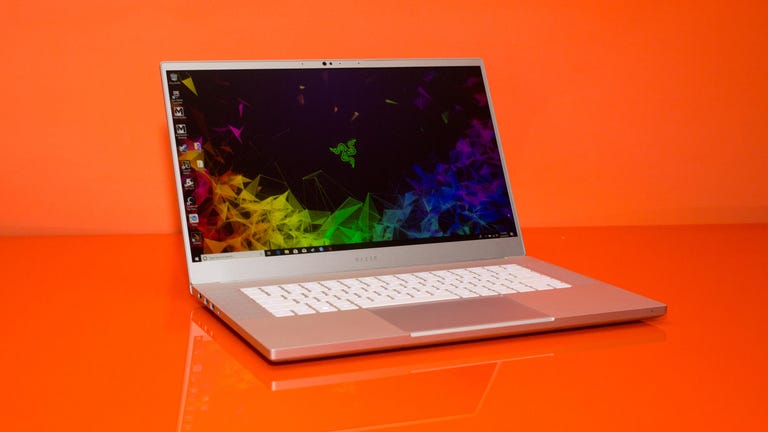 Why You Can Trust CNET
Why You Can Trust CNET Razer Blade Advanced (RTX 2060) review: One of our favorite gaming designs, but be prepared to pay for it
The 15-inch Razer Blade makes the jump to new Nvidia RTX graphics, but even the entry level RTX model is expensive.
When my PC gaming neighbor announced that he had just purchased a new gaming laptop, I was somewhat annoyed he hadn't come to me for laptop shopping advice. Then he told me he had gotten the new RTX 2060 version of the Razer Blade, and I couldn't be all that put out, because that's very likely what I would have recommended in the first place.
The Good
The Bad
The Bottom Line
This new version of the Blade, introduced at CES 2019, is virtually unchanged from the previous model, at least on the outside. Inside are new Nvidia GPUs from the RTX line. There are also a few tiny chassis adjustments to accommodate the new parts, plus a webcam that works with Windows Hello facial recognition.
But, so what? RTX GPUs and Intel Core i7-8750H CPUs are already common. What really sets the Razer Blade apart is the design and build quality, and to a lesser extent, the custom software.

Keeping up with bezel wars
The biggest jump in design came last year, when the Blade made a much-needed leap from a 14-inch screen to a 15-inch one, while keeping the footprint roughly the same and shaving down the screen bezels (the border around the display) to almost nothing.
This review version has the added benefit of Razer's optional Mercury White color scheme, which is only available in this RTX 2060 configuration. Along with a 512GB SSD and 144Hz 1,920x1,080-pixel display, it's a hefty $2,349 (£2,200, AU$3,899). Considering the hardware, design and extras, that may not be completely outrageous, but remember that pricing for laptops with the previous-gen Nvidia GTX 1060 GPU could easily get down to $899 or so -- with slower processors and less storage, of course.
In the Blade series, jumping up to the RTX 2070 or 2080 can add up to $700. In the opposite direction, Razer still sells a GTX 1060 configuration (just the Blade, without the "Advanced" tag) for $1,599.
Razer Blade 15
| Price as reviewed | $2,349, £2,200, AU$3,899 |
|---|---|
| Display size/resolution | 15.6-inch, 1,920x1,080-pixel display |
| CPU | 2.2GHz Intel Core i7-8750H |
| Memory | 16GB DDR4 SDRAM 2,666MHz |
| Graphics | 6GB Nvidia GeForce RTX 2060 |
| Storage | 512GB SSD |
| Networking | 802.11ac wireless, Bluetooth 5.0 |
| Operating system | Windows 10 Home (64-bit) |
Speed vs. style
If you're investing in a Razer Blade, you're more interested in design, style and comfort than raw frame rate-pushing power. Why do I say this? Because for around the same $2,300, you can get a Lenovo Legion Y740, with the higher-end Nvidia RTX 2080 Max-Q GPU.
But that's not necessarily the right answer. Especially if you spend a lot of time on nongaming laptop tasks, or use this as your main everyday laptop, these aesthetic and ergonomic choices become much more important.
In its white-and-silver edition, the Blade has a sophisticated professional look, and closely resembles a MacBook Pro . Unlike many other gaming laptops, you won't catch any flack for pulling this out at a corporate meeting (most likely just jealous stares).
If you do need to show off a little gaming flare, fire up the included Razer Synapse software, which offers many system control features, but will mostly be used for setting up the multicolored lighting effects for the keyboard, and switching between gaming and balanced power profiles. Razer Synapse requires you to register with an email address to use it, which I've always found unnecessarily stalkerish.
Power vs. heat
The biggest knock I can think of against the Razer Blade is that you're paying a premium (over $2,000) for the lower-end RTX 2060 GPU. In head-to-head tests, it's just not as powerful for gaming as the new RTX 2070 or RTX 2080, and also falls behind the older high-end GTX 1080 GPU. In some cases the differences are minimal, but in others there's a wide gap. Fortunately, you can trade up to those faster GPUs, and the RTX 2080 version, at $2,999, is actually competitively priced.
While the Blade 15 performed well in our testing, I have spoken to a few people who purchased this system at retail and complain about the heat generated by it. Thermal issues have also been discussed online in a few places. It's always hard to tell how widespread a hardware issue is, because only those who feel they're having a problem are likely to post about it.
Running some additional testing on our review unit, we found it did indeed get very hot, even with its aggressive fans kicking in. While gaming, the metal strip just above the keyboard quickly hit 120 F (49 C). The bottom panel, where the biggest vents are, got just as hot, so this isn't a laptop that belongs on your actual lap (at least while gaming). Internal CPU temperatures stayed in the mid-70s for us, but I've also seen online posts about CPU temps spiking into the 90s.
An undercover gaming laptop
Especially in its Mercury White version, the Razer Blade 15 combines the best of a mainstream creative laptop -- a slim design with an excellent screen and high-end CPU; with the best of a gaming laptop -- the latest graphics hardware, a high screen refresh rate, a game-friendly keyboard and cool programmable lights.
Two issues give me some pause. The system gets hot, no doubt about it, but the small number of serious online complaints may be outliers. I asked Razer to comment and the company said, in part, "This Blade actually handles thermals better than the previous generation."
The second issue is price, and this is one of the few times I'd suggest going for the highest-end model to get the best value. Too bad the well-priced RTX 2080 version is sadly not available in white right now.
Geekbench 4 (multicore)
Cinebench R15 CPU (multicore)
Video playback battery drain test (streaming)
3DMark Fire Strike Ultra
3DMark Port Royal (RTX)
System configurations
| Alienware Area-51m | Microsoft Windows 10 Home (64-bit); 3.6GHz Intel Core i9-9900K; 32GB DDR4 SDRAM 2,400MHz; 8GB Nvidia GeForce RTX 2080; (2) 512GB SSD RAID 0 + 1TB HDD |
|---|---|
| MSI GS75 Stealth 8SG (Nvidia RTX 2080 Max-Q) | Microsoft Windows 10 Home (64-bit); 2.2GHz Intel Core i7-8750H; 32GB DDR4 SDRAM 2,666MHz; 8GB Nvidia GeForce RTX 2080 with Max-Q Design; 512GB SSD |
| Acer Predator Triton 500 (Nvidia RTX 2080 Max-Q) | Microsoft Windows 10 Pro (64-bit); 2.2GHz Intel Core i7-8750H; 32GB DDR4 SDRAM 2,666MHz; 8GB Nvidia GeForce RTX 2080 with Max-Q Design; (2) 512GB SSD RAID 0 |
| Asus Zephyrus GX701 (Nvidia RTX 2080 Max-Q) | Microsoft Windows 10 Pro (64-bit); 2.2GHz Intel Core i7-8750H; 24GB DDR4 SDRAM 2,666MHz; 8GB Nvidia GeForce RTX 2080 with Max-Q Design; 1TB SSD |
| Lenovo Legion Y740-15 | Microsoft Windows 10 Home (64-bit); 2.2GHz Intel Core i7-8750H; 16GB DDR4 SDRAM 2,666MHz; 8GB Nvidia GeForce RTX 2070 with Max-Q Design; 256GB SSD + 1TB HDD |
| Razer Blade 15 (Nvidia RTX 2060) | Microsoft Windows 10 Home (64-bit); 2.2GHz Intel Core i7-8750H; 16GB DDR4 SDRAM 2,666MHz; 6GB Nvidia GeForce RTX 2060 with Max-Q Design; 512GB SSD |
| Lenovo Legion Y740-17 (Nvidia RTX 2080 Max-Q) | Microsoft Windows 10 Home (64-bit); 2.2GHz Intel Core i7-8750H; 16GB DDR4 SDRAM 2,666MHz; 8GB Nvidia GeForce RTX 2080 with Max-Q Design; 256GB SSD + 1TB HDD |
| Alienware 17 R4 (Nvidia GTX 1080) | Microsoft Windows 10 Home (64-bit); 2.9GHz Intel Core i7-7820HK; 16GB DDR4 SDRAM 2,400MHz; 8GB Nvidia GeForce GTX 1080 ; 512GB SSD + 1TB HDD |


